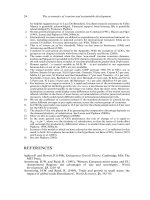THE ECONOMICS OF MONEY,BANKING, AND FINANCIAL MARKETS 370
Bạn đang xem bản rút gọn của tài liệu. Xem và tải ngay bản đầy đủ của tài liệu tại đây (32.92 KB, 1 trang )
338
PA R T I V
The Management of Financial Institutions
The bank manager could have gotten to the answer even more quickly by first calculating what is called a duration gap, which is defined as follows:
DURgap * DURa + a
where
L
, DURl b
A
(5)
DURa * average duration of assets
DURl * average duration of liabilities
L * market value of liabilities
A * market value of assets
Then, to estimate what will happen if interest rates change, the bank manager
uses the DUR gap calculation in Equation 4 to obtain the change in the market value
of net worth as a percentage of total assets. In other words, the change in the market value of net worth as a percentage of assets is calculated as
NW
i
* - DURgap *
A
1 + i
APP LI CAT IO N
(6)
Duration Gap Analysis
Based on the information provided in the previous Application, use Equation 5 to
determine the duration gap for the First Bank and then use equation 6 to determine the change in the market value of net worth as a percentage of assets if interest rates rise from 10% to 11%.
Solution
The duration gap for First Bank is 1.72 years.
DURgap = DURa + a
where
DURa * average duration of assets
L * market value of liabilities
A * market value of assets
DURl * average duration of liabilities
*
*
*
*
L
, DURl b
A
2.70
95
100
1.03
Thus
DURgap * 2.70 + a
95
, 1.03 b * 1.72 years
100
Hence, a rise in interest rates from 10% to 11% would lead to a change in the market value of net worth as a percentage of assets of +1.6%
NW
i
* + DURgap ,
A
1 + i









